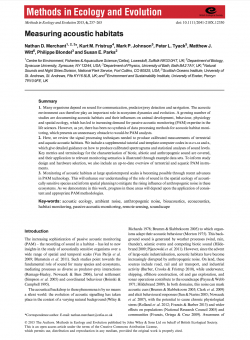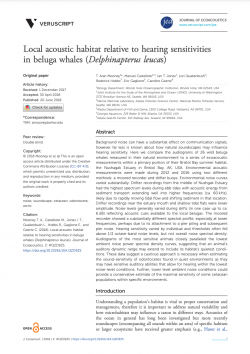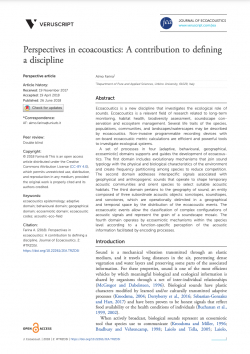Measuring acoustic habitats

Type
Journal
Authors
Category
Article
[ Browse Items ]
Publication Year
2015
Publisher
Methods In Ecology and Evolution, United Kingdom
URL
[ private ]
Volume
6
Pages
257-265
Tags
Abstract
1. Many organisms depend on sound for communication, predator/prey detection and navigation. The acoustic environment can therefore play an important role in ecosystem dynamics and evolution. A growing number of studies are documenting acoustic habitats and their influences on animal development, behaviour, physiology and spatial ecology, which has led to increasing demand for passive acoustic monitoring (PAM) expertise in the life sciences. However, as yet, there has been no synthesis of data processing methods for acoustic habitat moni- toring, which presents an unnecessary obstacle to would-be PAM analysts.
2. Here, we review the signal processing techniques needed to produce calibrated measurements of terrestrial and aquatic acoustic habitats. We include a supplemental tutorial and template computer codes in MATLAB and R, which give detailed guidance on how to produce calibrated spectrograms and statistical analyses of sound levels. Key metrics and terminology for the characterisation of biotic, abiotic and anthropogenic sound are covered, and their application to relevant monitoring scenarios is illustrated through example data sets. To inform study design and hardware selection, we also include an up-to-date overview of terrestrial and aquatic PAM instru- ments.
3. Monitoring of acoustic habitats at large spatiotemporal scales is becoming possible through recent advances in PAM technology. This will enhance our understanding of the role of sound in the spatial ecology of acousti- cally sensitive species and inform spatial planning to mitigate the rising influence of anthropogenic noise in these ecosystems. As we demonstrate in this work, progress in these areas will depend upon the application of consis- tent and appropriate PAM methodologies.
2. Here, we review the signal processing techniques needed to produce calibrated measurements of terrestrial and aquatic acoustic habitats. We include a supplemental tutorial and template computer codes in MATLAB and R, which give detailed guidance on how to produce calibrated spectrograms and statistical analyses of sound levels. Key metrics and terminology for the characterisation of biotic, abiotic and anthropogenic sound are covered, and their application to relevant monitoring scenarios is illustrated through example data sets. To inform study design and hardware selection, we also include an up-to-date overview of terrestrial and aquatic PAM instru- ments.
3. Monitoring of acoustic habitats at large spatiotemporal scales is becoming possible through recent advances in PAM technology. This will enhance our understanding of the role of sound in the spatial ecology of acousti- cally sensitive species and inform spatial planning to mitigate the rising influence of anthropogenic noise in these ecosystems. As we demonstrate in this work, progress in these areas will depend upon the application of consis- tent and appropriate PAM methodologies.
Description
https://doi.org/10.1111/2041-210X.12330
Number of Copies
1
| Library | Accession No | Call No | Copy No | Edition | Location | Availability |
|---|---|---|---|---|---|---|
| Main | 271 | 1 | Yes |




